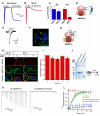Structure and analysis of nanobody binding to the human ASIC1a ion channel
- PMID: 34319232
- PMCID: PMC8318589
- DOI: 10.7554/eLife.67115
Structure and analysis of nanobody binding to the human ASIC1a ion channel
Abstract
ASIC1a is a proton-gated sodium channel involved in modulation of pain, fear, addiction, and ischemia-induced neuronal injury. We report isolation and characterization of alpaca-derived nanobodies (Nbs) that specifically target human ASIC1a. Cryo-electron microscopy of the human ASIC1a channel at pH 7.4 in complex with one of these, Nb.C1, yielded a structure at 2.9 Å resolution. It is revealed that Nb.C1 binds to a site overlapping with that of the Texas coral snake toxin (MitTx1) and the black mamba venom Mambalgin-1; however, the Nb.C1-binding site does not overlap with that of the inhibitory tarantula toxin psalmotoxin-1 (PcTx1). Fusion of Nb.C1 with PcTx1 in a single polypeptide markedly enhances the potency of PcTx1, whereas competition of Nb.C1 and MitTx1 for binding reduces channel activation by the toxin. Thus, Nb.C1 is a molecular tool for biochemical and structural studies of hASIC1a; a potential antidote to the pain-inducing component of coral snake bite; and a candidate to potentiate PcTx1-mediated inhibition of hASIC1a in vivo for therapeutic applications.
Keywords: ASIC1; MitTx antagonism; Pctx1 potentiation; cryo-electron microscopy; molecular biophysics; nanobody; structural biology.
© 2021, Wu et al.
Conflict of interest statement
YW, ZC, FS, CC No competing interests declared
Figures














Similar articles
-
Mambalgin-1 pain-relieving peptide locks the hinge between α4 and α5 helices to inhibit rat acid-sensing ion channel 1a.Neuropharmacology. 2021 Mar 1;185:108453. doi: 10.1016/j.neuropharm.2021.108453. Epub 2021 Jan 12. Neuropharmacology. 2021. PMID: 33450275
-
The modulation of acid-sensing ion channel 1 by PcTx1 is pH-, subtype- and species-dependent: Importance of interactions at the channel subunit interface and potential for engineering selective analogues.Biochem Pharmacol. 2019 May;163:381-390. doi: 10.1016/j.bcp.2019.03.004. Epub 2019 Mar 5. Biochem Pharmacol. 2019. PMID: 30849303
-
Conformational decoupling in acid-sensing ion channels uncovers mechanism and stoichiometry of PcTx1-mediated inhibition.Elife. 2022 Feb 14;11:e73384. doi: 10.7554/eLife.73384. Elife. 2022. PMID: 35156612 Free PMC article.
-
Mechanisms of Action of the Peptide Toxins Targeting Human and Rodent Acid-Sensing Ion Channels and Relevance to Their In Vivo Analgesic Effects.Toxins (Basel). 2022 Oct 17;14(10):709. doi: 10.3390/toxins14100709. Toxins (Basel). 2022. PMID: 36287977 Free PMC article. Review.
-
Acid-sensing ion channel (ASIC) structure and function: Insights from spider, snake and sea anemone venoms.Neuropharmacology. 2017 Dec;127:173-184. doi: 10.1016/j.neuropharm.2017.04.042. Epub 2017 Apr 27. Neuropharmacology. 2017. PMID: 28457973 Review.
Cited by
-
Structure of the human heterodimeric transporter 4F2hc-LAT2 in complex with Anticalin, an alternative binding protein for applications in single-particle cryo-EM.Sci Rep. 2022 Oct 30;12(1):18269. doi: 10.1038/s41598-022-23270-1. Sci Rep. 2022. PMID: 36310334 Free PMC article.
-
Nanobody engineering: computational modelling and design for biomedical and therapeutic applications.FEBS Open Bio. 2025 Feb;15(2):236-253. doi: 10.1002/2211-5463.13850. Epub 2024 Jun 19. FEBS Open Bio. 2025. PMID: 38898362 Free PMC article. Review.
-
AFTM: a database of transmembrane regions in the human proteome predicted by AlphaFold.Database (Oxford). 2023 Mar 14;2023:baad008. doi: 10.1093/database/baad008. Database (Oxford). 2023. PMID: 36917599 Free PMC article.
-
Structural determinants of acid-sensing ion channel potentiation by single chain lipids.J Gen Physiol. 2022 Jul 4;154(7):e202213156. doi: 10.1085/jgp.202213156. Epub 2022 May 18. J Gen Physiol. 2022. PMID: 35583813 Free PMC article.
-
Modulating ion channels with nanobodies.Synth Syst Biotechnol. 2025 Feb 18;10(2):593-599. doi: 10.1016/j.synbio.2025.02.005. eCollection 2025 Jun. Synth Syst Biotechnol. 2025. PMID: 40103710 Free PMC article. Review.
References
-
- Chassagnon IR, McCarthy CA, Chin YK-Y, Pineda SS, Keramidas A, Mobli M, Pham V, De Silva TM, Lynch JW, Widdop RE, Rash LD, King GF. Potent neuroprotection after stroke afforded by a double-knot spider-venom peptide that inhibits acid-sensing ion channel 1a. PNAS. 2017;114:3750–3755. doi: 10.1073/pnas.1614728114. - DOI - PMC - PubMed
Publication types
MeSH terms
Substances
Grants and funding
LinkOut - more resources
Full Text Sources
Research Materials
Miscellaneous

